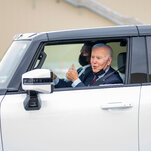
Biden Orders Federal Vehicles and Buildings to Use Renewable Energy by 2050

Under an executive order, the federal government would phase out the purchase of gasoline-powered vehicles, and its buildings would be powered by wind, solar or other clean energy.


WASHINGTON — President Biden on Wednesday set in motion a plan to make the federal government carbon neutral, ordering federal agencies to buy electric vehicles, to power facilities with wind, solar and nuclear energy, and to use sustainable building materials.
In a series of executive orders, Mr. Biden directed the government to transform its 300,000 buildings, 600,000 cars and trucks, and use its annual purchases of $650 billion in goods and services to meet his goal of a federal government that stops adding carbon dioxide into the atmosphere by 2050.
From his earliest days in office, Mr. Biden said he intended to use the federal government as a model and to help spur the markets for green energy. The executive orders signed Wednesday set a timetable for the transition.
By 2030, Mr. Biden wants the federal government to purchase electricity produced only from sources that do not emit carbon dioxide, the most plentiful of the human-caused greenhouse gases that are warming the planet. By 2032, the Biden administration wants to see the emissions from building operations, such as heating, cut in half. And by 2035, all new federal cars and truck purchases would also be zero-emissions.
The move comes as Mr. Biden is struggling to turn many of his climate goals into reality. He has promised to cut America’s emissions from fossil fuels roughly in half by the end of this decade. But Congress has not yet approved a $1.7 trillion spending bill that would help achieve that target. The Supreme Court also appears poised to limit the federal government’s ability to use certain regulatory actions to tackle climate change.
The procurement goals could go a long way in transforming the clean energy markets, experts said.
“It’s a similar strategy to what China is doing so successfully, leveraging the purchasing power of their government to create demand that markets can meet,” said Joshua Freed, senior vice president for climate and energy at Third Way, a centrist Democratic research group.
“The federal government in so many areas is one of, if not the largest, purchaser,” Mr. Freed said. “Having the certainty the government is going to purchase cleaner products, materials and vehicles enables companies to move in that direction.”
Unlike most executive orders that undergo a lengthy and sometimes fractious regulatory process before they are enacted, procurement rules can take effect almost immediately, said Richard L. Revesz, a professor of environmental law at New York University. He called the executive orders “very significant.”
Still, the orders could be reversed by a future administration. And the plan does not cover purchasing by the Department of Defense, which accounts for a large portion of the government’s energy spending. Clean energy purchases could also cost the government more money in the short run, and many of the components like electric charging stations for an all-electric federal vehicle fleet have not yet been built.
Republicans already are mounting opposition to the plan. On Wednesday Senator John Barrasso of Wyoming, the top Republican on the Senate Committee on Energy and Natural Resources, denounced it as “disgraceful” and said the plan would harm workers in the fossil fuel sector.
“This is not build back better,” he said in a statement. “It’s another backbreaking move to build bigger bureaucracy.”
The plan Mr. Biden set forth presents significant challenges for the administration.
Just 40 percent of the electricity purchased by the federal government now comes from renewable sources like wind and solar. The goal is to ramp that up to 100 percent in less than a decade. The federal government currently consumes just 1.5 percent of the nation’s energy, although it is a major player in certain states where it has significant operations, such as Virginia, California, Georgia and North Carolina.
In converting its power to wind, solar and other sources that don’t produce planet-warming emissions, the government intends to follow the path set by companies like Google, Apple and Wal-Mart, which established tariffs or developed power-purchase agreements with local utilities to achieve their goals of 100 percent renewable energy, a senior administration official said.
The requirement to purchase only zero-emissions vehicles by 2035 is even more difficult.
Currently electric vehicles represent only about 1.5 percent of the government fleet. In fiscal year 2021 the administration purchased 650 electric vehicles, according to the administration, a number it hopes to increase several-fold this year and beyond. The government buys about 50,000 vehicles a year, many of those are replacements.
“That’s about half the annual output of one factory, about half of one percent of all vehicles sold every year,” said Steven Koonin, a physicist who was an under secretary of energy under President Barack Obama and who is now a climate policy fellow at the American Enterprise Institute, a conservative research organization. “It’s small potatoes.”
He called the electric vehicle plan more symbolic than game-changing. “If you go through the numbers, there’s no impact on emissions or the vehicle market,” said Mr. Koonin, whose views on climate change are at odds with the established scientific consensus.
Meanwhile, Robin Carnahan, the administrator of the General Services Administration, which oversees federal purchasing, called the plan “a massive opportunity to create millions of clean energy jobs, save taxpayer money through reduced energy costs, and build a more sustainable future for generations of Americans.”
Some environmental groups, however, said they did not believe the executive orders go far enough. Bill Snape, a senior counsel at the Center for Biological Diversity, said the goal of making the federal government carbon neutral by 2050 “is like a teenager promising to clean their room in 30 years.”
He and others called on the administration to do more, faster, and said they were frustrated by the legislative pace of the spending bill, which Mr. Biden has called his Build Back Better plan. Activists said they found the administration’s commitment lacking in light of a decision last month to open more than 80 million acres in the Gulf of Mexico to oil and gas drilling.
“Biden can’t use this one executive order to cover up the fact that Build Back Better, our best chance at meaningful climate legislation in his administration, has not passed,” Deirdre Shelly, campaign director of the Sunrise Movement, a climate change advocacy group, said. She called on Mr. Biden to “stand up against the fossil fuel industry.”
Coral Davenport contributed reporting.
Source: https://www.nytimes.com/2021/12/08/climate/biden-government-carbon-neutral.html
















